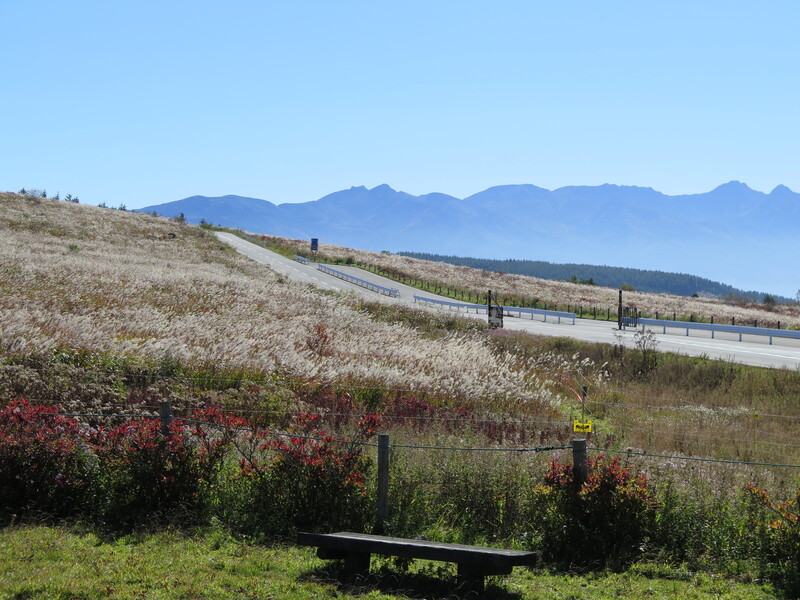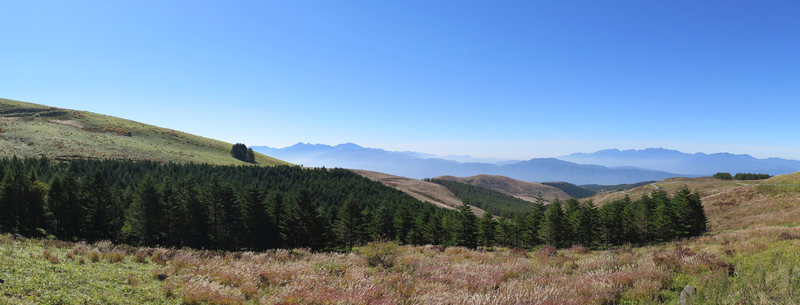The Venus Line
2014-09-29
On Saturday, my school had its annual Sports Day, where everyone runs relay races, throws balls, and tugs on ropes. Apparently there's a manual of some one hundred events, and P.E. teachers choose fifteen or twenty of those events to do at their school. It's something like the school picnics we had back when I was an elementary school student, except that now I work at a junior/senior high and everyone is a little older. On Sunday I had nothing to do, so I put some stuff in a backpack, got on my motorcycle, and headed west through the mountains of Saitama, Gunma, and on into Nagano. My aim was the Venus Line.
In my waterproof backpack were a rain jacket, rain pants, two USB battery packs, a USB cable, a toothbrush, toothpaste, a pair of socks, a t-shirt, long underwear, a long sleeve undershirt, neoprene motorcycle gloves, gaiters, a book, and a camera. I used everything except for the gaiters, the book, and one of the battery packs. Bob Dylan said, "When you got nothing, you got nothing to lose."
The plan was to follow the squiggles on the map labeled "Highway 299" west from Chichibu to Nagano. That was great until I came to a sign. I didn't read the sign, because I was moving fast and it was written in Japanese. That didn't matter, because five minutes later there was another sign, but this time bigger, in the middle of the road, and with less text. It read, "Road closed ahead." So I made a quick U-turn, went back to the first sign, and turned right onto another road. This road was half the size of the first and was twice as squiggly. These squiggles were called "Highway 124". The name was apt, because after approximately 124 turns, I got to the top of the pass. It was slow going — mostly first gear with a dash of second gear on the straightaways. Night had fallen, and the only signs of life were two cars, a bicyclist, and a fox. The moon and stars shone brightly there in the middle of nothing. On the other side of the pass, the road straightened out and farmhouses and telephone polls began to dot the landscape.
Once inside the trailer my senses adjust to the new situation and soon enough, writing the letter, I lose awareness of the lights and the whine of the motor. But I have cut myself off completely from the greater world which surrounds the man-made shell. The desert and the night are pushed back — I can no longer participate in them or observe; I have exchanged a great and unbounded world for a small, comparatively meager one. By choice, certainly; the exchange is temporarily convenient and can be reversed whenever I wish.
Finishing the letter I go outside and close the switch on the generator. The light bulbs dim and disappear, the furious gnashing of pistons whimpers to a halt. Standing by the inert and helpless engine, I hear its last vibrations die like ripples on a pool somewhere far out on the tranquil sea of desert, somewhere beyond Delicate Arch, beyond the Yellow Cat badlands, beyond the shadow line. I wait. Now the night flows back, the mighty stillness embraces and includes me; I can see the stars again and the world of starlight. I am twenty miles or more from the nearest fellow human, but instead of loneliness I feel loveliness. Loveliness and a quiet exultation.
— Edward Abbey, Desert Solitaire (1968).
If you want to travel fast and light on a motorcycle, the best choice for lodging is a hotel or, for the budget biker, a net cafe. There are fewer net cafes than hotels, so you have to look them up in advance. Net cafes are noisier and not for light sleepers. But you get your own private booth, a computer to use, unlimited soft drinks and coffee, and a blanket, all for a quarter the price of a hotel. I wouldn't recommend this net cafe to anyone; it had a non-smoking section, but the air filters don't work properly. At least it was quiet and clean.
In the morning I took a side road, Highway 199, up to the Venus Line. Highway 199 is the perfect small road. It appears to have been drawn on the side of the hill by a drunk caffeine addict with the precision of a preschooler. The road veers right and left, over the ridge line, across the stream, by the small dam, and back again. It does so with no particular plan other than eventually reaching the pass. After thirty minutes of slow slaloming, you get to the pass.
The Venus Line (ビーナスライン) is a stretch of highway in the mountains of Nagano. It begins in the south in Chino. Highway 192 leads NE into the mountains. The road continues north, then becomes Highway 40 and heads west for a spell. The Venus Line branches north again onto Highway 194 and continues north toward Ueda. The Venus Line has many overlooks of the Minami Alps. Unlike many other scenic roads in Japan, it's entirely free. You could probably make a day trip to it from Osaka or Tokyo. An overnight trip is more relaxing.
The tree line is starkly visible up here. The wind cuts across the grassy fields on the top of the plateau. I take a long break for a can of coffee. Before starting up again, I put my rain gear on overtop my riding clothes. The rain gear cuts the wind, which is half the reason I carry it. It's a sunny day today and by the late afternoon my eyes will be sore. But for now it's yet morning and there are places to go. Rather, there are roads to be ridden, and where the road ends is less important than everything before it.
one who breakfasts
with morning glories:
that’s what I am
asagao ni / ware wa meshi ku / otoko kana
— Matsuo Basho (1644-1694)
I stop at an overlook to see the mountains. A group of old women and men are disappointed that I speak Japanese, because they wanted to practice their English. Then they realize they can practice it anyway — what am I going to do, refuse to speak English? — and they tell me that the mountain off in the distance with smoke over it is in fact Mount Ontake (御嶽山) which erupted two days ago. I read about the eruption in the news when it happened but didn't know where the mountain was until now.
A total of 31 climbers are believed to have died near the peak of Mt. Ontake, which erupted Saturday, the Nagano prefectural police department said Sunday. Of the victims, four people were brought down from the 3,067-meter mountain, which straddles Nagano and Gifu prefectures, by rescue workers, the local police said, adding that some climbers who spent a night in Mt. Ontake have descended the mountain on their feet but chances cannot be ruled out that there are other people left there.
— Jiji Press, 31 feared dead on Mt. Ontake (2014-09-28).
I covered 471.8 km on the trip. The way there was local roads and took a long time. The way back was the expressway: first south, then east on the Chuo Expressway, a leisurely ride past Kofu and Otsuki and Hachioji. It was a clear day, and Mount Fuji lingered on the south. When you see Mount Fuji from far away, it looms above the other mountains. Sometimes you don't even notice it, because it's poking out above the clouds and there's no reason to look up there — at least, not if you didn't know better. But when you're closer to the behemoth, the foothills are relatively larger too, and the illusory effect is gone; the mountain looks normally huge. All too soon the view fades away and you realize you're back in western Tokyo. It was hot in Tokyo this afternoon. Autumn has come to the mountains, but it seems the big city is lingering in late summer.
wind from Mt. Fuji—
carrying it in my fan,
a souvenir for those in Edo
fuji no kaze ya / ogi ni nosete / edo miyage
— Matsuo Basho (1644-1694)



